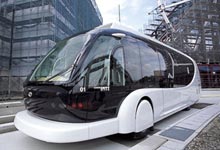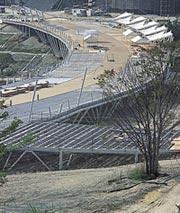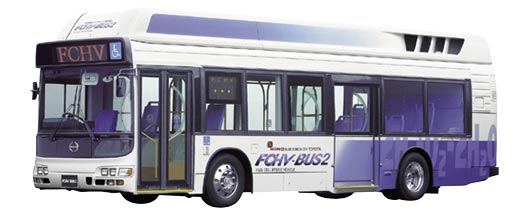|
Special Feature*
 |
Each Intelligent Multimode Transit System (IMTS) vehicle is the size of a large bus and carries 50 passengers (16 long seats). The convoys will run at an interval of 10 minutes.
|
Automatic convoy system
Intelligent Multimode Transit System (IMTS)
The vehicles look like large buses as they pass by in a convoy, separated from each other by about 20 meters. There are no drivers—they are guided automatically by magnets embedded in the roadway. At a branch point, some vehicles leave the convoy and drivers come on board. Then the vehicles are driven on ordinary roads. This is how the new Intelligent Multimode Transit System could work.
At one Expo 2005 site, a convoy of three vehicles will carry visitors on an IMTS roadway (length, 1.6 km). At a branch point along the way, one of the vehicles will leave the convoy, become a manned route on an ordinary road, carry passengers to their destination about 0.8 km away, then return to the dedicated roadway and join the automated convoy again. Maximum speed at the Expo will be 30 km/hr, although the vehicles are capable of moving as fast as conventional ones because they run on natural gas. Developers say the system could be used one day for mid-size mass transit networks in smaller cities where it would not be feasible to construct a subway.
Running on fuel cells and battery-powered electricity
Hybrid Buses
The two Expo sites, Nagakute and Seto, are about 3.5 km apart from each other. To travel from one to the other, visitors will board hybrid buses powered by two sources of energy—fuel cells and nickel-metal hydride secondary batteries. The fuel cells store hydrogen and use oxygen from the air to generate electricity directly through a hydrogen/oxygen electrochemical reaction. The buses emit only water, generally in the form of water vapor. Electricity from the secondary batteries is generated and used, with no exhaust. These hybrid buses therefore produce no harmful emissions.
The buses, developed by Toyota Motor Corporation, each have two fuel cells with an output of 90 kW. The large-capacity secondary battery stores electricity generated by the motor when the bus brakes. When power from the fuel cells is not enough, such as when a fully loaded bus climbs a hill, the secondary battery supplies electrical energy to power the motor. The buses resemble ordinary ones, but you will notice the difference when they pass close by—no exhaust fumes and very little noise.


|
The Global Loop, photographed just before completion. Events will be held in different places on the decking, and rest areas are available under it.
|
|
 |
Tomorrow's technology for today's walkers
The Global Loop
The Expo's Nagakute Area has a rugged topography, but rather than shave off the hills and fill in the valleys, the developers decided to construct a wooden, nearly horizontal walkway with an average height of 7.5 meters. Called the Global Loop, the walkway circles the site over a distance of 2.6 km. It averages 21 meters in width.
Every 200 meters or so, a passageway lets you leave the Loop, giving easy access to all of the pavilions. The Loop is sturdily built, and has a 6-meter-wide space in the middle for electrically driven emergency vehicles. The designers aimed for a pedestrian paradise—the floor is treated to reduce sunlight reflection, the gradient is a maximum 1:20, and access is wheelchair-friendly. All this shows that tomorrow's transportation systems do not necessarily have to be for motorized traffic.
|
|


